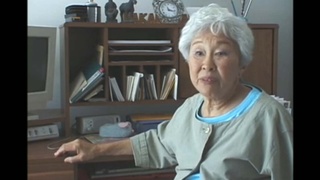Interviews
Allyship after camp
When we came back from camp, um, San Bernardino does not have a Japanese community, right, but there was a Chinese market, and it was run by a family called the Kwoks. We could not have our store without them because they were the only butcher and they had a, a butcher store on, uh, a butcher thing, and they eventually opened up what is, a, a pretty big market, there used to be, called Palace Market, real supermarket, which is one of the first ones out there and everyone in our family, me, my brother, my sisters, both of them, all worked there.
But after the war, there were certain companies that wouldn’t sell. You know, my father, still does not like, um, it’s Langendorf, or Pepsi. Because they asked to, to get their products in the store and they said, we don’t sell to Japs. We could not get meat.
So, they said, we’re here, you know. So, we got to be friends, my sister especially became friends with Rosemary Kwok, and they became good friends. But we would have to walk, it must have been over a mile, I can’t remember, we had to go through a meadow get up into a thing. And my father would order the meat and we’d then put the meat on our shoulders. And we were relatively small kids, all of us had to kind of lug it through the hot sun to our store. And that’s how we got our meat products there, you know.
Date: September 8, 2011
Location: California, US
Interviewer: John Esaki, Kris Kuramitsu
Contributed by: Watase Media Arts Center, Japanese American National Museum
Explore More Videos

Involvement in JACL
(b.1935) American born Japanese. Retired businessman.

Her experience as a Japanese-American schoolchild in Oceanside, California, after the bombing of Pearl Harbor
(1924-2018) Artist and playwright.

His parents' experience with Japanese resistance toward intermarriage with Okinawans
(b.1925) Nisei of Okinawan descent. Had a 38-year career in Japan as a baseball player, coach, scout, and manager.

Treatment of Kibei after return to United States
(b.1913) Kibei from California who served in the MIS with Merrill’s Marauders during WWII.

Finding work in the assembly center
(b.1913) Kibei from California who served in the MIS with Merrill’s Marauders during WWII.

Train ride to Jerome Relocation Center
(b.1913) Kibei from California who served in the MIS with Merrill’s Marauders during WWII.

Getting citizenship back
(b.1909) Nisei from Washington. Incarcerated at Tule Lake and Minidoka during WWII. Resettled in Chicago after WWII

Evacuation
(b.1909) Nisei from Washington. Incarcerated at Tule Lake and Minidoka during WWII. Resettled in Chicago after WWII

Conditions at Pinedale Assembly Center
(b.1909) Nisei from Washington. Incarcerated at Tule Lake and Minidoka during WWII. Resettled in Chicago after WWII

Making craft items from shells found at Tule Lake
(b.1909) Nisei from Washington. Incarcerated at Tule Lake and Minidoka during WWII. Resettled in Chicago after WWII

Response to loyalty questionnaire
(b.1909) Nisei from Washington. Incarcerated at Tule Lake and Minidoka during WWII. Resettled in Chicago after WWII

Move from Tule Lake to Minidoka
(b.1909) Nisei from Washington. Incarcerated at Tule Lake and Minidoka during WWII. Resettled in Chicago after WWII

Apprehension about leaving camp
(b.1909) Nisei from Washington. Incarcerated at Tule Lake and Minidoka during WWII. Resettled in Chicago after WWII

Difficulties finding apartment in Chicago after leaving Minidoka
(b.1909) Nisei from Washington. Incarcerated at Tule Lake and Minidoka during WWII. Resettled in Chicago after WWII

Under suspicion after Pearl Harbor
(b. 1924) Political scientist, educator, and administrator from Hawai`i
